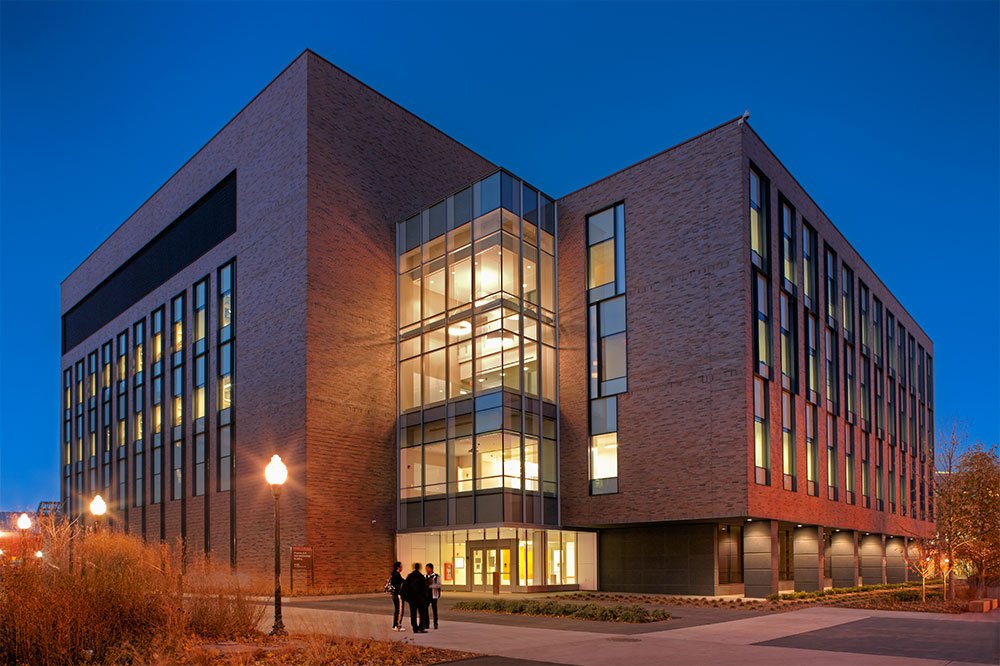Physics and Nanotechnology building open

Kneeling in meditative pose, the statues of a woman and a man outside the new Physics and Nanotechnology (PAN) building project solidity and strength, like the steel they're made from.
Until you move directly behind or in front of one, in which case both all but disappear, and you can see through them.
In physics, too, a lot depends on how you look at something; light, for example, is both a particle and a wave. Called Spannungsfeld, quantum physicist-cum-sculptor Julian Voss-Andreae's work translates as a tension field, as between opposites like male-female, positive-negative, or matter-antimatter.
Appropriately, the building is the new home for faculty ranging from nanotechnology researchers studying the ultratiny to cosmologists probing the origins of the universe. Plus, it houses facilities of the Minnesota Nano Center, where researchers from inside and outside the University develop and test nanoscale materials and devices.
“Now we can compete with other schools that have new physics and nanotech facilities,” says Ron Poling, professor and head of the U's School of Physics and Astronomy.
High and mighty
The most spectacular room is the high bay, a gargantuan laboratory in which payloads up to 25 feet tall can be moved. One beneficiary is physics professor Shaul Hanany, who studies the cosmic microwave background, a faint glow left over from the Big Bang that harbors clues to the universe’s origin.
His experimental apparatus is a telescope plus a receiver that houses detectors that are cooled to 0.025 degree above absolute zero. The entire apparatus is mounted in a 25-foot-tall gondola. The experiments are flown by balloon in Antarctica.
“We built the cryogenic receiver here, but not the entire experiment because we didn’t have a high bay to house the large gondola,” says Hanany.
Instead, the gondola was built at Columbia University. Sending the receiver to Columbia to be integrated, in stages, into the gondola meant costly scheduling difficulties.
Now, “having a high bay gives us the capability to do full payloads here,” Hanany says. “Over the 10- to 15-year life of one of our projects, this could potentially save hundreds of thousands of dollars.”
Calm and quiet
The physics of living organisms is generating increased interest, but many experiments require pinpoint environmental controls. On that score, U biophysicist Jochen Mueller gives PAN high marks.
“This building is amazing with respect to temperature and humidity control,” he says. “When you use lasers, they’re very sensitive to both.”
Mueller studies the assembly of infectious retrovirus particles, with an eventual aim of finding a way to disrupt it. Using lasers and a microscope, he traces individual molecules of a viral protein that’s essential to the process.
PAN offers not only humidity and temperature control, but a vibration-damped environment to keep microscope stages steady. With these improvements, the School of Physics and Astronomy's contingent of biophysicists, which includes associate professor Vincent Noireaux and just-hired assistant professor Elias Puchner, can continue to grow.
Clean and neat
PAN now houses the second clean room of the U’s Minnesota Nano Center, where researchers fabricate and test materials and devices built on the scale of nanometers. There, the tiniest speck of dust is a serious contaminant.
“The ability to process materials with increasingly finer resolution is essential to nanoconductor technologies and others,” says Daniel Frisbie, a Distinguished McKnight University Professor in the Department of Chemical Engineering and Materials Science whose work could lead to new kinds of switching devices. “The facilities [in PAN] will affect our ability to tailor materials at the nanometer level—that’s incredibly important for new devices and new research on how materials behave at that scale.”
The center’s facilities are also open to qualified persons from other institutions or the private sector on a fee-for-service basis.
“That’s one of the roles we fulfill—providing tools and expertise to companies that otherwise couldn't afford them,” says Jim Marti, senior scientist and outreach coordinator for the center.
One user is Jesse Cole of SVT Associates, an Eden Prairie, Minnesota, firm that produces semiconductor materials used in light-sensing devices. He needs an MNC clean room to test the effectiveness of each step in making the materials.
“That allows us to develop devices faster, because we’re able to test after running each process to see how well it worked,” he says. “It’s very useful to have fabrication and measurement [testing] in the same place.”
“The number of users has grown from 30 to 330 in the [original clean room] in Keller Hall,” says MNC Director Stephen Campbell. “We started with just electronics and optics, and built the new facility to accommodate a wider breadth and number of users.”
A major growth area for nanotechnology is biomedical: Neural implants, devices to track single-molecule disease markers, and encapsulation of drug molecules are just a few applications. Campbell foresees growth to some 800 users in MNC.
“People now see the state and University's commitment [to supporting new nanomaterials and technologies],” says Campbell. “This really is one of the finest facilities of its kind in the country.”
